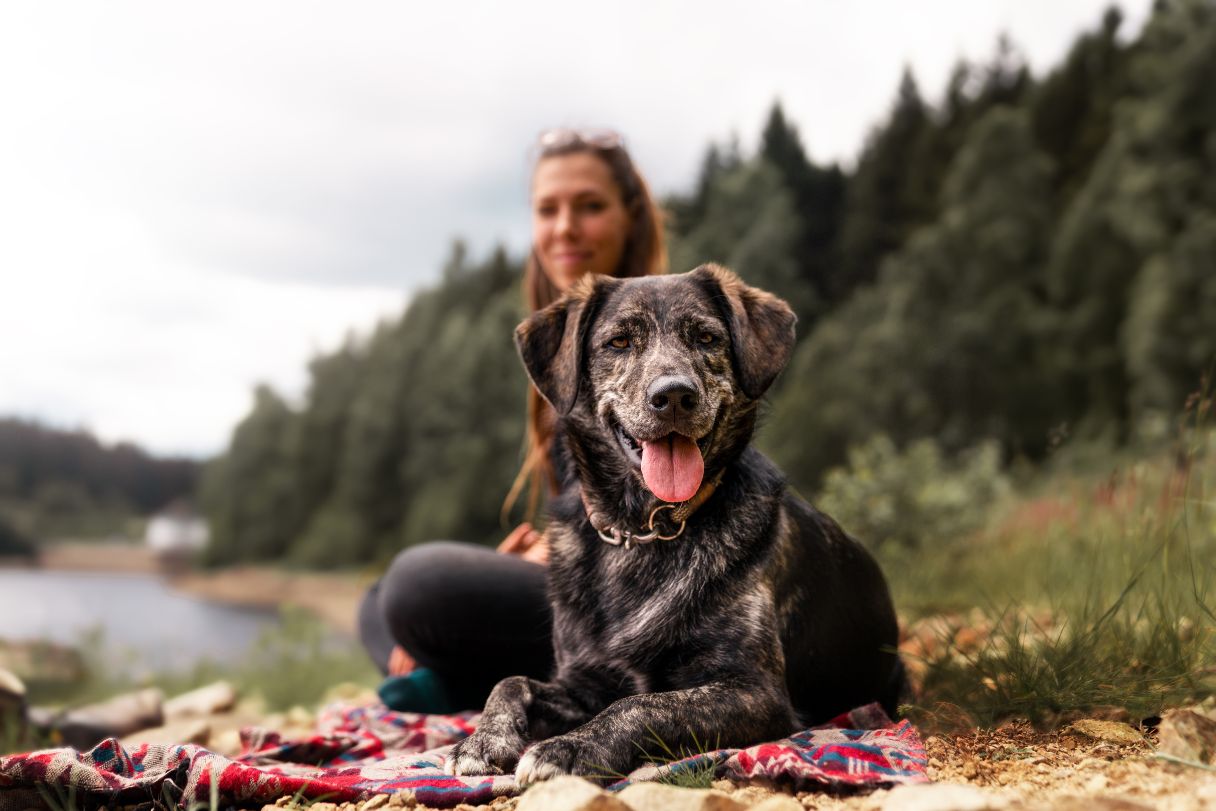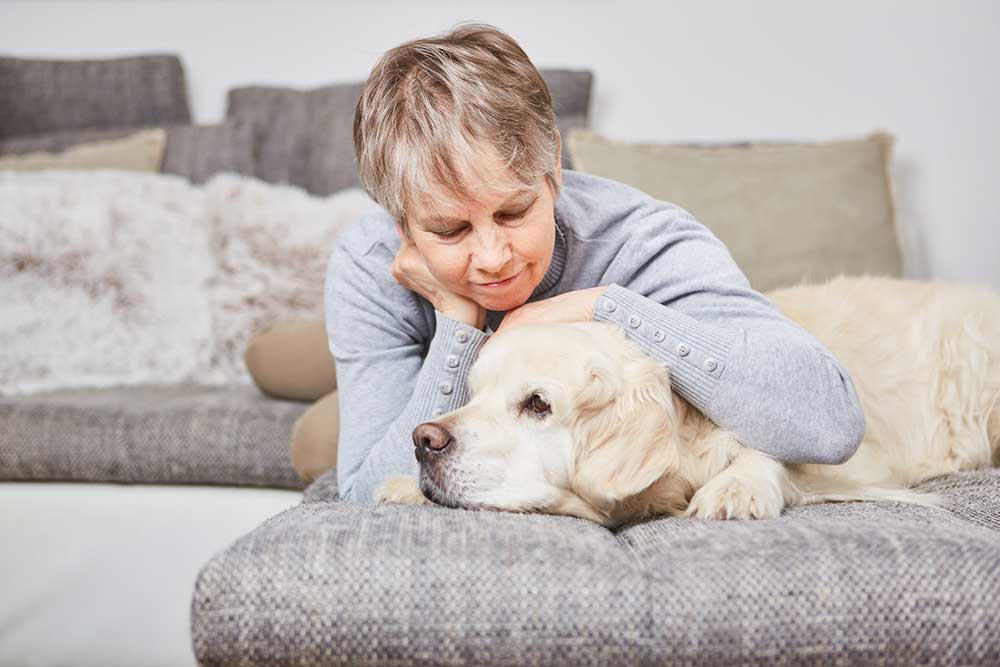Puppy kisses may be sweet, but there’s nothing like being greeted by a graying muzzle that speaks to years of loyalty and a very special bond. While your senior dog may still be going strong, you might begin to notice they’re slowing down or needing more TLC. Below, we'll outline some tips to help you navigate your senior dog’s changing needs to help your aging pup enjoy their golden years.
When Does a Dog Become Senior?
A dog is considered a senior when they’ve reached the last fourth of their breed’s life expectancy. Because dogs of different breeds and sizes age at different rates, there is no hard and fast age at which dogs become senior. But generally speaking, here’s when dogs begin to enter their senior years:1
| Size of dog | Senior age |
|---|---|
| Under 20 pounds | 8 to 11 years |
| 20 to 50 pounds | 8 to 10 years |
| 50 to 90 pounds | 8 to 9 years |
| Over 90 pounds | 6 to 7 years |
Senior dogs go through a lot of changes as they age, which may impact how you interact with and care for them. These 11 tips will help you anticipate those changing needs and provide proper care for your senior pooch.
1. Watch Their Weight
Proper nutrition for your senior dog can help prevent weight gain as their metabolism slows down, along with a wide range of both weight- and age-related health conditions. Senior dog food is formulated to provide the nutrition your dog needs with fewer calories per serving, but it’s still important to measure each serving to make sure you’re not overfeeding them.2
However, dogs who are really advanced in age may need additional calories and protein to help them keep weight on. Ultimately, it’s best to talk to your vet about your aging dog’s diet as their needs change, and have regular weigh-ins to make sure they’re maintaining a healthy weight.2
2. Keep Their Water Bowl Full
Proper hydration is as important as proper nutrition to your senior dog’s health. But aging dogs often forget to drink as much as they should. Provide plenty of clean, fresh water in several locations around the house so they don’t need to go far to get a drink, and consider a dog water fountain to ensure the water is always fresh and flowing.2
It’s important to monitor your aging pup’s water intake, as excessive thirst and water consumption can be a sign of serious illness, such as diabetes or kidney disease. Either way, it’s a good idea to bring any drastic changes in your dog’s water consumption to the attention of your vet.3
3. Pay Attention to Grooming Needs
A dog’s coat may need more attention as they age. Brushing them regularly will not only help them stay shiny and tangle-free, but it will also give you a chance to check them over for any lumps, bumps or skin changes that could indicate a serious health issue. It’s also important to keep up with nail trims to prevent foot pain and balance or joint issues from overgrown nails.4
4. Be Proactive With Dental Care
Regular toothbrushing to prevent periodontal disease is important throughout your dog’s life, but senior dogs are especially susceptible to problems. It’s important to keep up with toothbrushing and have their teeth checked every six months.5
Heart disease and other age-related illnesses can make some dogs poor candidates for anesthesia, so don’t put off having problematic teeth extracted while they’re healthy enough to undergo the procedure.
Also, a dog’s teeth tend to weaken as they age. Your super chewer may need to switch to softer dog toys that are easier on their chompers.5
5. Help Them Feel Safe and Comfortable
Some of the changes your dog goes through as they age may stress them out. Changes in vision, hearing, mobility, health and cognitive function can all produce anxiety in senior dogs, as well as making it difficult for them to get comfortable.6 Depending on their needs, here are a few ways you can help your aging pup feel more secure:
- Place rugs, yoga mats or carpet runners on hard surfaces where they walk, and use paw balm to help increase their grip on slippery surfaces.4
- Use pet gates or exercise pens to block off stairs or other parts of the home where they might get hurt, especially if dealing with vision loss or canine dementia.
- If they’re crate trained, cover their crate with a blanket to make it feel safer and cozier.
- Provide plenty of comfortable spots to lounge or snooze, and consider switching to memory foam beds that are supportive and easier on the joints.4
- Use a heating pad — wrapped in a towel or blanket to prevent burns — to help soothe tired and aching joints.
- Use a diaper or belly band, or puppy training pads, to help prevent accidents in incontinent dogs.
6. Make Adjustments for Greater Accessibility
Make accommodations to keep your senior dog from having to climb or jump more than necessary. This might include low steps up to the bed or the couch, or ramps to get up and down the front steps or in and out of the car.4
If your home has more than one floor, keep all their stuff on the ground floor to reduce their need to travel upstairs. Adjust their play and exercise to be more low-impact and easier on their joints.4 For example, instead of jogging, aim for slow, leisurely walks, moving at your pooch’s pace.5
7. Consider Supplements for Arthritis
While maintaining a healthy weight is one of the best things you can do for an arthritic dog, adding omega-3 fatty acids to their diet can also help lower inflammation that causes arthritis and joint pain.7 Glucosamine and chondroitin supplements may also help to repair wear and tear to cartilage in joints and alleviate pain.8
8. Support Their Vision or Hearing Changes
While some underlying causes of vision and hearing loss are treatable, it’s normal for senior dogs to lose at least some of their hearing or eyesight as they grow older. It’s important to understand that these conditions can cause dogs to startle more easily, which could cause them to snap. You’ll need to be patient with them and supervise young children around them, teaching kids how to avoid frightening them.5
Dogs usually adapt well to a loss of their senses, but you may need to learn new ways to communicate with them. Blind dogs may rely more on sound, touch, texture and smell, while deaf dogs who can no longer hear tone of voice may become more attuned to your body language and facial expressions. They may even be able to learn sign language. For their safety, it’s especially important to keep impaired dogs on a leash and keep them close to you during walks.9
9. Encourage Play and Exercise
In addition to physical movement to help maintain mobility and a healthy weight, aging dogs need the mental stimulation that comes with exercise and engaging play. The mental engagement that comes from remaining as active as possible will help prevent the cognitive decline that can lead to dementia. Continue their training, socialization, play time and walks for as long as possible. When walks are no longer an option, consider other ways to help your aging pup stay active and engaged, such as going on car rides and taking them for a walk in a stroller or wagon.4
10. Spend Time With Them
It’s hard to face the prospect that your furry best buddy is running out of time, but it’s important to keep that in mind. As they slow down, take that as a cue to slow down, make time to just be with them and do the things they’re still capable of enjoying. It will mean the world to your pup, and you’ll create memories that will stay with you long after they’re gone.
11. Find and Work With a Supportive Vet
It’s generally recommended that senior dogs should see a vet for checkups every six months in order to keep a watchful eye on their health.3 It’s important to find a vet with whom both you and your dog have a good rapport and who is caring and supportive as you navigate the last years, months and weeks of your pup’s life. Your vet will be able to guide you through making decisions for your dog, up to and including when it’s time to let them go.
Learn More
Find a Veterinarian Near You
Caring for Your Senior Dog
Senior dogs can be both challenging and rewarding, and living with and caring for them can include heartbreaking lows and laugh-out-loud moments of joy. Whether they stay in good health or struggle to feel good, your main goal is to help them be as healthy and comfortable as they can for as long as you can.
In addition to regular vet checkups, it’s best to report any changes in their health or behavior to your vet so they can act quickly. Loving your dog through good nutrition, meeting all their health and wellness needs and spending lots of quality time with them will go far when it comes to making their final years truly golden.
CareCredit Credit Card Financing for Dogs
Taking good care of your pet's well-being from nose to tail is essential. Make sure to stay up to date on their regular checkups at the vet to help keep your pet happy and healthy for a lifetime of love. You can use your CareCredit credit card for pet care throughout the year for routine veterinary services as well as emergencies and surgeries.* Use our Acceptance Locator to find a veterinarian near you that accepts CareCredit.
CareCredit is there for you and your pet every step of the way; continue your wellness journey by downloading the CareCredit Mobile App to manage your account, find a provider on the go and easily access the Well U blog for more great articles, podcasts and videos.
In addition to pet care, you can also use your CareCredit credit card for dentistry, cosmetic, vision, hearing, health systems, dermatology, pharmacy purchases, spa treatments and so much more within the CareCredit network. How will you invest in your health and wellness next?
Author Bio
Jean Marie Bauhaus is a freelance writer and novelist who has been writing pet content since 2013. Her work has appeared on Forbes.com, Hill's Pet, Chewy, AKC.org and more.







